The Archbasilica of Saint John Lateran, often simply known as the Lateran Basilica, holds an unparalleled position within the Catholic Church and the city of Rome. More than just one of Rome’s many churches, it is the Cathedral of Rome, the official ecclesiastical seat of the Bishop of Rome – the Pope himself. This distinction elevates it above all other churches in the Catholic world, including the famed St. Peter’s Basilica in Vatican City. As the Papal Archbasilica and the oldest public church in the West, the Basilica Of St John Lateran is steeped in history, art, and profound religious significance, inviting pilgrims and visitors alike to explore its remarkable legacy.
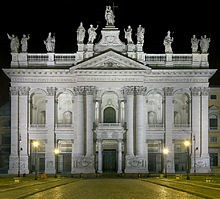 Basilica of Saint John Lateran facade
Basilica of Saint John Lateran facade
From Roman Fort to Papal Cathedral: A Historical Journey
The very ground upon which the Basilica stands is layered with history. Before its Christian incarnation, the site was occupied by a fort belonging to the Roman imperial cavalry bodyguard. This guard served Maxentius, the rival of Constantine the Great. Following Constantine’s decisive victory at the Battle of the Milvian Bridge in 312 AD, a pivotal moment in Roman history that Constantine attributed to divine intervention, he dissolved the guard and ordered the demolition of their fort. In an act of thanksgiving, Constantine chose this very location to build an early Christian Basilica, dedicating it to Christ the Savior.
Adjacent to the fort lay the Domus Laterani, the palace of the influential Laterani family, during the Roman Empire. This estate came into the possession of the Emperor when Constantine married Fausta, Maxentius’s sister. Constantine gifted the palace and land to Pope St. Miltiades, marking the beginning of the site’s papal association. In 313 AD, Pope Miltiades convened a significant Council within the Domus Laterani to address the Donatist schism, an early controversy within the Christian Church. While initially dedicated to the Savior, it was during the papacy of Gregory I (590-604) that the church was rededicated to St. John the Baptist and St. John the Evangelist, the Apostle and author of the Fourth Gospel, solidifying its name and patronage.
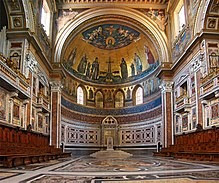 Exterior view of the Lateran Basilica with obelisk
Exterior view of the Lateran Basilica with obelisk
The official dedication of the Archbasilica and the adjacent Lateran Palace by Pope St. Sylvester I occurred on November 9, 324 AD. He proclaimed both as the “Domus Dei,” the “House of God,” underscoring its sacred nature and importance. The Papal Cathedra, the Bishop of Rome’s official chair, was placed within the Basilica, formally establishing it as the Cathedral of Rome. Reflecting its primacy, an inscription on the front wall, between the main entrance doors, proclaims: “Of all the churches in the city and in the world, this is the mother and head of all.” This powerful declaration emphasizes the Basilica of St John Lateran’s unique position within the Catholic Church hierarchy.
From Pope St. Miltiades onwards, every Pope resided in the Lateran Palace, making it the center of papal life and governance for centuries. This era continued until French Pope Clement V made the controversial decision to move the official seat of the Catholic Church to Avignon, France, in 1309.
The Lateran Basilica and Palace were not merely residences; they were also the venues for significant events in Church history. Five Ecumenical Councils, gatherings of Church leaders to address doctrine and practice, were held here in 1123, 1139, 1179, 1215, and 1512-1517. These councils are historically known as the Lateran Councils, further cementing the Basilica’s central role in shaping Catholic theology and law.
Trials and Tribulations: Destruction and Rebirth
The period of the Avignon Papacy (1309-1376) marked a time of neglect for the Lateran complex. With the Popes absent in France, the Lateran Palace and Archbasilica suffered significant deterioration. Devastating fires in 1307 and 1361 inflicted severe damage. Although funds were sent from Avignon for reconstruction, the Basilica and Palace never fully regained their former splendor during this period of papal absence.
Upon the return of the Papacy to Rome, the extent of the damage was evident. The Lateran Palace and Archbasilica were deemed inadequate and in disrepair after decades of neglect. Consequently, the Popes initially resided at the Basilica di Santa Maria in Trastevere, and later at the Basilica di Santa Maria Maggiore. Eventually, the Vatican Palace, adjacent to St. Peter’s Basilica, was constructed and became the primary papal residence. The Popes resided there until Pope Francis’s decision to reside at the Domus Santa Marta, a guesthouse within Vatican City.
Despite the shift in papal residence, the Basilica of St John Lateran remained the Cathedral of Rome, and efforts to restore its grandeur were undertaken. However, it was not until the papacy of Pope Sixtus V (1585-1590) that a comprehensive and definitive reconstruction plan was realized. Sixtus V commissioned the architect Domenico Fontana to undertake this ambitious project.
Fontana’s reconstruction was extensive. The original Lateran Palace was demolished and replaced with a new, more modern structure. The square in front of the Lateran Palace was also redesigned and became the location for a remarkable monument: the Lateran Obelisk. This obelisk, the highest and most ancient in Rome, is one of the city’s thirteen obelisks, more than any other city worldwide. Carved in the fifteenth century BC, it originally stood in the Karnak temple of Thebes, Egypt. Emperor Constantius II brought it to Rome in 357 AD and erected it in the Circus Maximus. After centuries, it fell and broke into pieces, becoming buried under the Circus Maximus. Rediscovered and excavated in the 16th century, Pope Sixtus V had it restored and placed on a new pedestal in 1588 at the northern entrance to the Archbasilica, a testament to Rome’s layered history and imperial past.
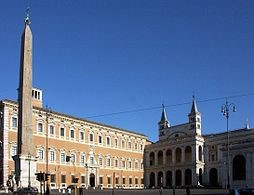 The Lateran Obelisk in front of the Basilica
The Lateran Obelisk in front of the Basilica
Further renovations continued into the 17th and 18th centuries. Pope Innocent X (1644-1655) entrusted Francesco Borromini, a prominent Baroque architect, with the renovation of the Basilica’s interior. It was during this period that St. John Lateran, as it is often called, began to develop a distinct style, differentiating it from the other papal basilicas.
Borromini maintained the nave with five aisles, a feature shared with St. Peter’s Basilica and St. Paul Outside-the-Walls. However, his most striking intervention was along the central nave: he created twelve large niches in an elegant white style. By 1718, each niche was filled with a colossal statue of an apostle, sculpted by renowned Roman Rococo artists. These impressive Baroque figures, often overlooked in guidebooks, are a defining characteristic of the Lateran Basilica. Each statue is accompanied by significant symbols that aid in meditating on the apostle’s life and death, such as St. Bartholomew holding his flayed skin, a graphic reminder of his martyrdom.
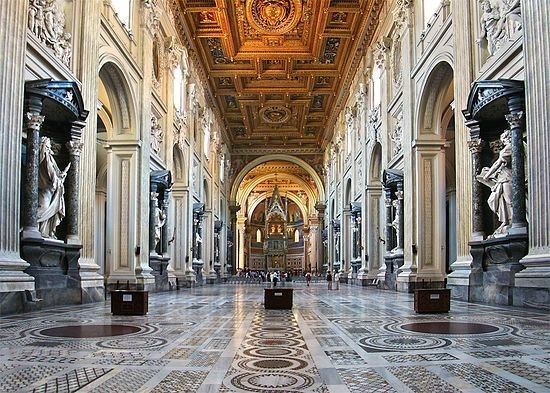 Statue of an Apostle inside the Basilica
Statue of an Apostle inside the Basilica
Above these statues, high reliefs in white stucco, designed by Alessandro Algardi in 1659, depict scenes from the Old and New Testaments. Algardi and his collaborators ingeniously created a “biblical concordance,” presenting the life of Jesus as prefigured in the Old Testament narratives. For example, the story of Jonah emerging from the sea serpent after three days on one side of the nave is mirrored by the scene of Christ’s Resurrection on the opposite side, highlighting the typological relationship between the Old and New Testaments.
Pope Clement XII (1730-1740) undertook the final major reconstruction phase, focusing on the Basilica’s façade. Designed by Alessandro Galilei, a relative of the famous astronomer Galileo Galilei, the façade was completed in 1735. Its imposing and palatial design resembles the front of a grand palace more than a traditional church façade, reflecting the Basilica’s status and importance. The inscription on the façade, in Latin, reads: “Pope Clement XII, in the fifth year of his reign, dedicated this building to Christ the Savior, in honor of Saints John the Baptist and John the Evangelist.”
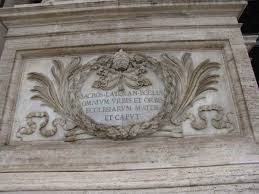 Facade of the Basilica of St John Lateran
Facade of the Basilica of St John Lateran
The façade features five entrance doors. The rightmost door is the Holy Door, a significant feature opened only every 25 years during Jubilee years. This ritual was first performed in this Basilica by Pope Martin V in 1423 and later extended to the other Roman Basilicas. Above the doors, the entablature is adorned with fifteen colossal statues. In the center stands Christ the Savior, flanked by St. John the Baptist and St. John the Evangelist. These central figures are further surrounded by the twelve Doctors of the Greek and Latin Churches, symbolizing the doctrinal unity of the Church.
Artistic and Religious Treasures: Exploring the Interior
The Apse Mosaic, located in the sanctuary and apse, is a breathtaking masterpiece created by two Franciscan friars, Jacopo Torriti and Jacopo da Camerino, in the 13th century. The upper section depicts Christ the Savior amidst clouds and surrounded by angels, a common motif in Byzantine-inspired mosaics.
The lower section presents a gathering of significant figures: St. Paul, St. Peter, St. Francis of Assisi, Our Lady, St. John the Baptist, St. Anthony of Padua, St. John the Apostle, and St. Andrew (from left to right). A small figure kneeling near Our Lady represents Pope Nicholas IV, whose patronage of the Lateran was praised by Dante Alighieri in his Paradiso. Above the jeweled crucifix, the Holy Spirit is depicted as a dove, from whose beak water flows down the sides of the Cross, dividing into four streams representing the Gospels. These streams flow into the Jordan River at the base of the mosaic, which is teeming with life. Stags and sheep drink from these Gospel sources, symbolizing Baptism and the life-giving power of the Holy Spirit. The entire mosaic is a rich theological allegory of salvation, the Gospels, and the sacraments.
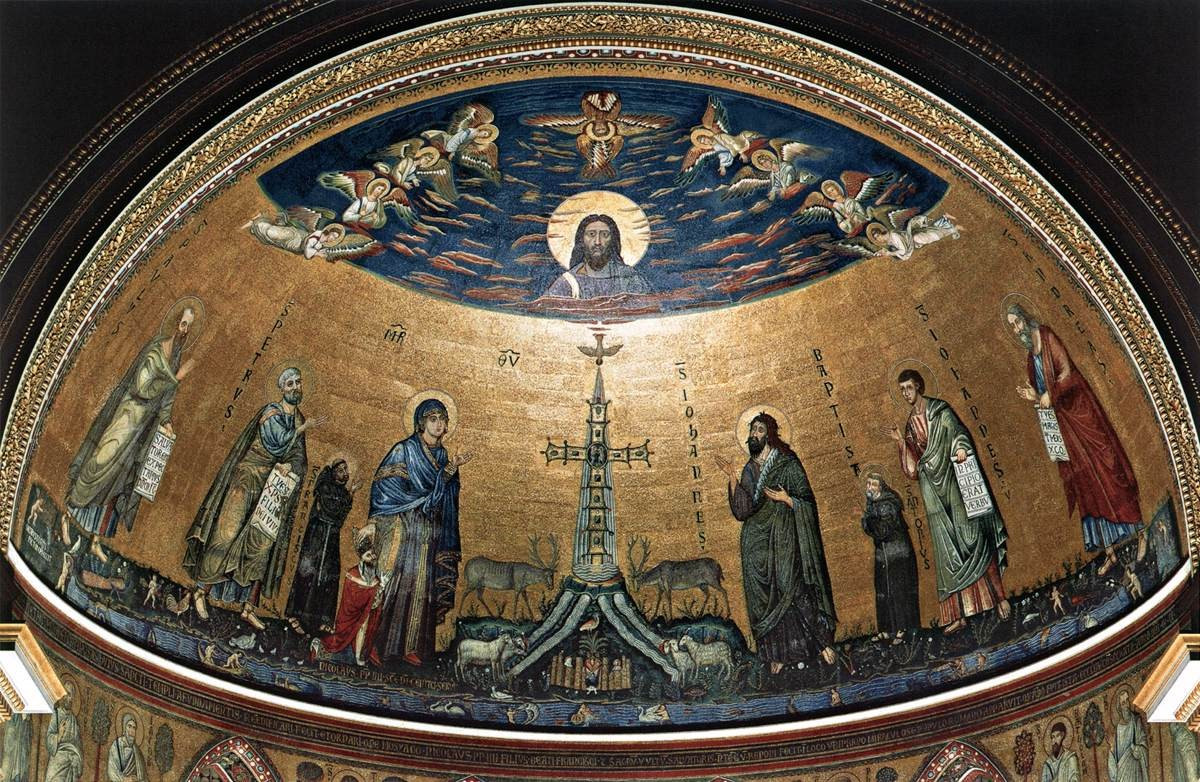 Apse Mosaic in the Basilica of St John Lateran
Apse Mosaic in the Basilica of St John Lateran
The Basilica is also home to numerous relics, objects of religious significance and veneration. The canopy or baldacchino over the high altar dates back to 1369. This Gothic structure, resting on four marble columns and adorned with paintings, houses in its upper part the busts of the Apostles Peter and Paul. Tradition holds that parts of the skulls of St. Peter and St. Paul are enshrined within these busts, making them some of the Basilica’s most treasured relics.
Beneath the baldacchino lies the papal altar. While the current altar is a modern construction, it encloses the ancient wooden altar used until the fourth century by the first thirteen Popes, from St. Peter to St. Sylvester, for celebrating the Eucharist. This ancient altar connects the modern Basilica to the earliest days of the papacy.
To the left of the Papal Altar stands another ancient table, positioned above the altar where the Blessed Sacrament is reserved. Behind a bronze relief of the Last Supper, tradition claims that this table is the very one upon which Jesus and the apostles celebrated the Last Supper, further linking the Lateran Basilica to the foundational events of Christianity.
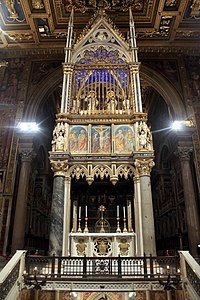 Baldacchino and Papal Altar in the Basilica
Baldacchino and Papal Altar in the Basilica
Beyond the Basilica Walls: Scala Sancta and Baptistery
Just outside the Basilica, in a small park, stands a monument to St. Francis of Assisi and his companions. St. Francis is depicted facing the Basilica with outstretched arms. From a specific vantage point, it appears as if St. Francis is supporting the church, recalling the dream of Pope Innocent III in 1209. Innocent III dreamt of seeing the Lateran Basilica on the verge of collapse and a humble man supporting it. He later recognized St. Francis as this man, understanding that St. Francis’s message of poverty and simplicity would spiritually renew the Church.
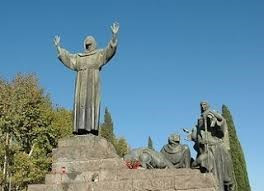 Statue of St. Francis of Assisi outside the Basilica
Statue of St. Francis of Assisi outside the Basilica
Inside the Basilica, the tomb of Pope Innocent III is another point of interest, often depicting Jesus, St. Dominic, and St. Francis, reflecting the Pope’s recognition of these important figures in Church history.
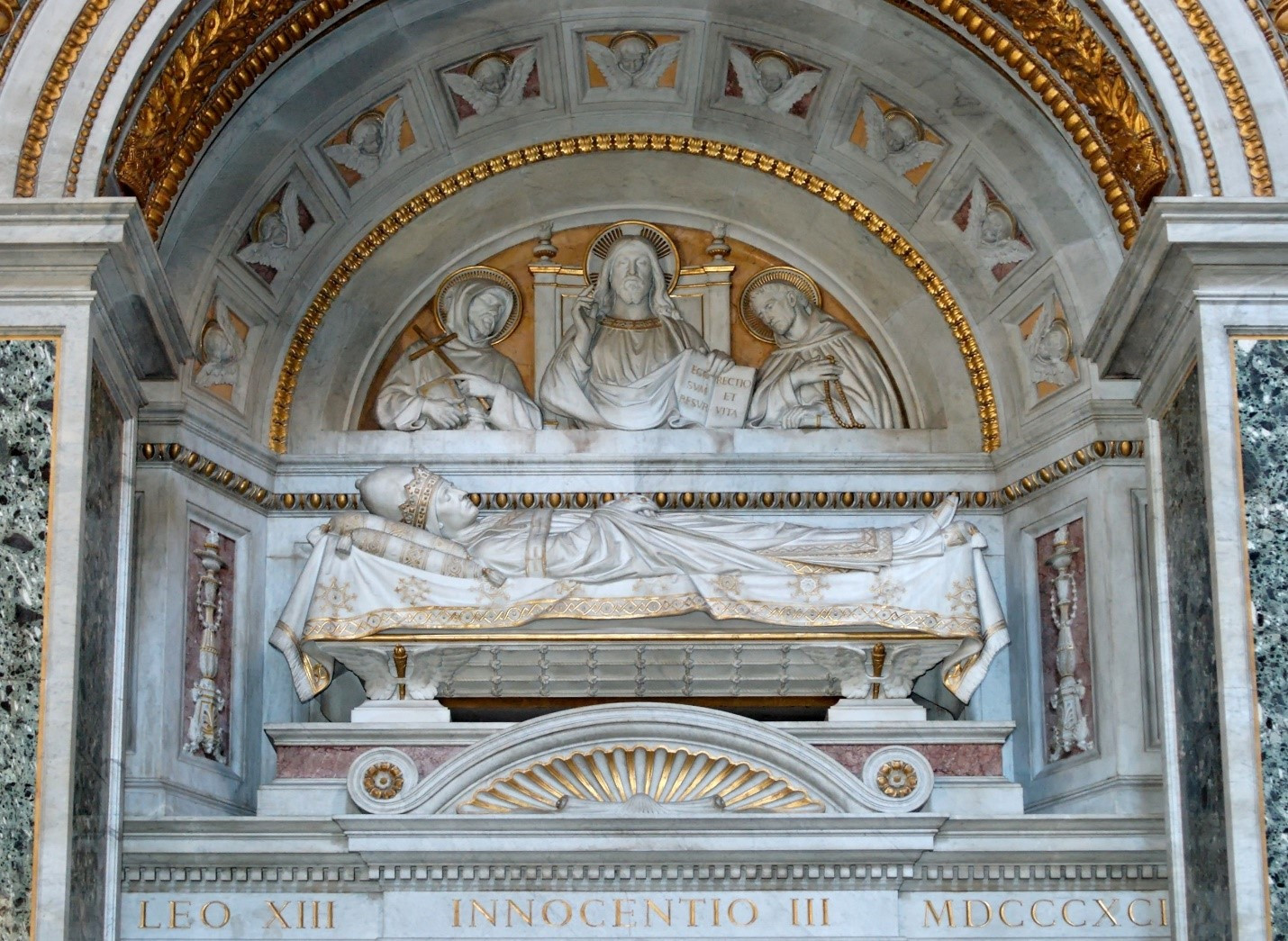 Tomb of Pope Innocent III inside the Basilica
Tomb of Pope Innocent III inside the Basilica
Nearby the Archbasilica lies the Scala Sancta, or Holy Stairs. In 1586, when Sixtus V rebuilt the Lateran Palace, Domenico Fontana incorporated the grand staircase of the old palace, consisting of 28 marble steps. Legend states that St. Helena, Constantine’s mother, brought these steps to Rome in the fourth century from the praetorium of Pontius Pilate in Jerusalem. If authentic, these are the steps Jesus would have climbed on his way to trial before his crucifixion. For centuries, pilgrims have ascended the Scala Sancta on their knees in veneration of Christ’s Passion. Encased in wood for protection since the early 1700s, the stairs were briefly exposed for restoration in 2019, allowing pilgrims to ascend the original marble steps on their knees for the first time in almost 300 years, a powerful experience of devotion and historical connection.
At the top of the Scala Sancta is the Sancta Sanctorum, once the private chapel of the Pope, housing further relics and sacred art.
The Baptistery, a separate octagonal building close to the Basilica, is the original baptistery founded by Constantine in the fourth century. Its octagonal shape is symbolic, representing the eight days of creation and the new creation in Christ. Eight porphyry columns support the architrave, topped by eight smaller porphyry columns.
In the center, steps lead down to the baptismal font. Traditionally, baptism was performed by partial immersion, with candidates descending into the water up to their knees, and water poured three times over their head. While Constantine founded the baptistery, he himself was not baptized there, deferring baptism until shortly before his death in 337 AD.
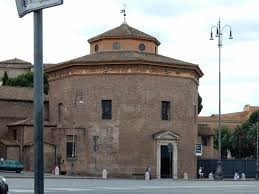 Exterior of the Lateran Baptistery
Exterior of the Lateran Baptistery
Reflection on the Mother Church
The Basilica of St John Lateran stands as a monument to centuries of Christian history, art, and faith. As the Mother Church of Rome and the world, its dedication is celebrated annually on November 9th. It serves as a powerful reminder of the enduring presence of God and the rich spiritual heritage of the Catholic Church. Visiting the Basilica of St John Lateran is not just a tour of a historical site, but a pilgrimage into the heart of Christian tradition and a profound encounter with faith made visible in stone, mosaic, and art.


